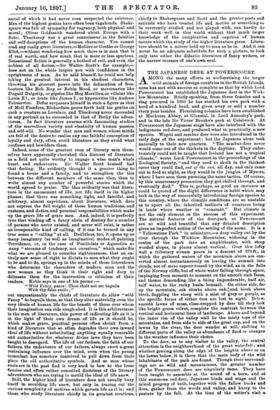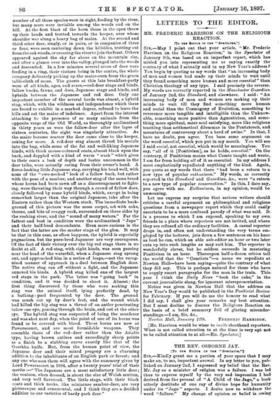'11:11, JAPANESE DEER AT POWERSCOURT.
AMONG the many efforts at acclimatising the larger wild animals of foreign countries in the British Islands, none has met with success so complete as that by which Lord Powerscourt has established the Japanese deer in the Wick- low Mountains. Briefly speaking, from three females and a stag procured in 1860 he has stocked his own park with a herd of a hundred head, and given away or sold a number every year besides. Flourishing colonies have been established at Muckross Abbey, at Glenstal, in Lord Annesley's park, and in the late Sir Victor Brooke's park at Colebrook. At Powerscourt the Japanese stags have also interbred with the indigenous red-deer, and produced what is, practically, a new species. Wapiti and sambur deer were also introduced in the early days of the experiment ; but the Japanese alone took naturally to their new quarters. "The sambur-deer never would come out of the thickets in the daytime. They unfor- tunately could not be taught that Ireland has not a tropical climate," wrote Lord Powerscoart in the proceedings of the Zoological Society, "and they used to skulk in the thickest cover they could find, out of the sun, all day, and only came out to feed at night, as they would in the jungles of Mysore, where I have seen them pursuing the same tactics. Of course, by this unnecessary precaution they got chilled through, and eventually died." This is, perhaps, as good an instance as could be quoted of the slight differences in habit which may lurk in the way of successfully introducing foreign species to this country, where the climatic conditions are so unstable as to upset all the inherited instincts of creatures living in lands where weather is "constant." But climate is not the only element in the success of this experiment. The natural features of the deer-park at Powerscourt are so wild and beautiful that any detailed description gives an imperfect notion of the setting of the scene. It is a "Yellowstone Park" in miniature,—a deep valley cut by the river through the Wicklow Mountains, widening in the centre of the park into an amphitheatre, with steep wooded slopes, in places almost vertical. Over this lofty wall a tributary stream pours in a descent of 370 ft., in which the gathered waters of the mountain above are con- verted almost instantaneously on leaving the summit into clouds, not of mere vapour tossed by the wind, as in the falls of the Norway cliffs, but of white water falling through space, impinging from moment to moment on the smooth rock faces, and thence descending like a thing imponderable, half air, half water, to the rocky basin beneath. On either side, far up the mountain, 'oak climbs above oak,; and birch above birch, dappling the steep with a mist of grey or purple, as the specific forms of either tree are lost to sight. Below, smooth lawns of moss, close-cropped by deer till they look like bright green velvet, complete the contrast between the vertical and horizontal lines of landscape. Above and beyond the inner rim of the valley wall lie the misty tops of the mountains, and from side to side of the great cup, and on the lawns by the river, the deer wander at will, shifting to different parts of the valley as abundance of food or changes in the weather influence their choice.
To the deer, as to any visitor to the valley, the central attraction is the neighbourhood of the great waterfall ; and whether grazing along the edge 'of the heights above or on the lawns below, it is there that the main body of the wild inhabitants of the park are found. Though their surround- ings are so wild and mountainous, the greater number of the Powerscourt deer are singularly tame. They have been taught to assemble at the sound of a horn, and at this summons red-deer, Japanese hinds and stags. and the mixed progeny of both, together with the fallow bucks and does, gather from the woods and valley, and hurry to the pasture by the falL At the time of the writer's visit a
number of all these species were in sight, feeding by the river, but many more were invisible among the woods and on the hill. At the first blast of the horn those in the open threw up their heads and trotted towards the keeper, over whose shoulder was slung a heavy bag of maize. At the second and third other deer, singly, or in pairs, or in companies of three or four, were seen cantering down the hillsides, trotting out from the oak woods, or crossing the river to join the feast. Others appeared against the sky far above on the mountain rim, and after a glance over into the valley, plunged into the woods and descended. In a few minutes several score of deer were feeding in a ring, their visitors being in the centre, the whole company delicately picking up the maize-corn from the green table-cloth of moss. The guests at this late breakfast-party were of all kinds, ages, and sexes,—red-deer stags and hinds, fallow bucks, fawns, and does, Japanese stags and hinds, and hybrids between the Japanese and red deer. Only one important member of the several herds was absent, a hybrid stag, which, with the wildness and independence which these are found to exhibit in a marked degree, refused to leave the hills and eat the maize of indolence. Apart from the interest attaching to the presence of so many animals from the opposite verge of the Old World, as thoroughly acclimatised in thirty years as were the fallow-deer after the lapse of sixteen centuries, the sight was singularly attractive. As the maize became scarcer the deer came close to the keeper, asking for more. A red-deer stag almost thrust his muzzle into the bag, while some of the fat and well-liking Japanese hinds, with thick mouse-coloured coats, almost black upon the back, and dappled with a kind of warm " wash " which gives to their coats a look of depth and lustre uncommon in the deer tribe, were actually eating from their owner's hand. A fierce-looking little Japanese stag, carrying his head well, with none of the "ewe-necked" look of a fallow buck, but rather with the pose of a sambur, and another stag of the same breed whose horns had been sawn off as a discouragement to fight- ing, were thrusting their way through a crowd of fallow does, closely followed by some hybrid hinds, which, except in being somewhat larger than the original Japanese, take after the Eastern rather than the Western stock. The immediate back- ground of this picture was the moss carpet, set with oaks, thorns, and bits of craggy rock, surrounded on three sides by the rushing river, and the "sound of many waters." Far the fattest and beat in condition were the acclimatised "Jape" and their half-bred descendants. Even more curious is the fact that the latter are the master stags of the glen. It may be that in this case, as often happens, the hybrid is especially pugnacious, but the pure-bred Japanese are very courageous. Of the fact of their victory over the big red stags there is no doubt at all. A red stag, with eight hinds, was seen passing near the head of the waterfall, when a Japanese stag sprang out, and approached him in a series of leaps,—not the recog- nised manner of approach in a duel between English deer. The native stag ran off without a fight, and the Japanese annexed his hinds. A hybrid stag killed one of the largest red stags in the park. The latter was "going back" in condition, and it was decided to shoot it. Almost ; the first thing discovered by those who were seeking this stag was the animal itself, lying perfectly dead, by a bathing - pool frequented by the deer. The ground was much cut up by deer's feet, and the wound which had killed the big stag was a thrust of an antler penetrating below one eye, passing through the brain, and out at the other eye. The hybrid stag was suspected of being the murderer and was shot next day, when the point of one of its horns was found to be covered with blood. These horns are now at Powerscourt, and are most formidable weapons. They resemble those of the red-deer rather than the Asiatic type, having brown antlers and exceedingly sharp points as a finish to a stabbing curve exactly like that of the Goorkha knife. But, from the human point of view, the Japanese deer and their mixed progeny are a charming addition to the inhabitants of an English park or forest; and any one who sees them will agree with the summary given by Lord Powerscourt in 1884, after a twenty years' trial of their merits :—" The Japanese are a most satisfactory little deer; the venison, when dressed, is about the size of Welsh mutton, and very well flavoured. The little stags, with their black coats and thick necks, like miniature sambur-deer, are very picturesque and ornamental, and I think they are a decided additior to our varieties of hardy park deer."







































 Previous page
Previous page